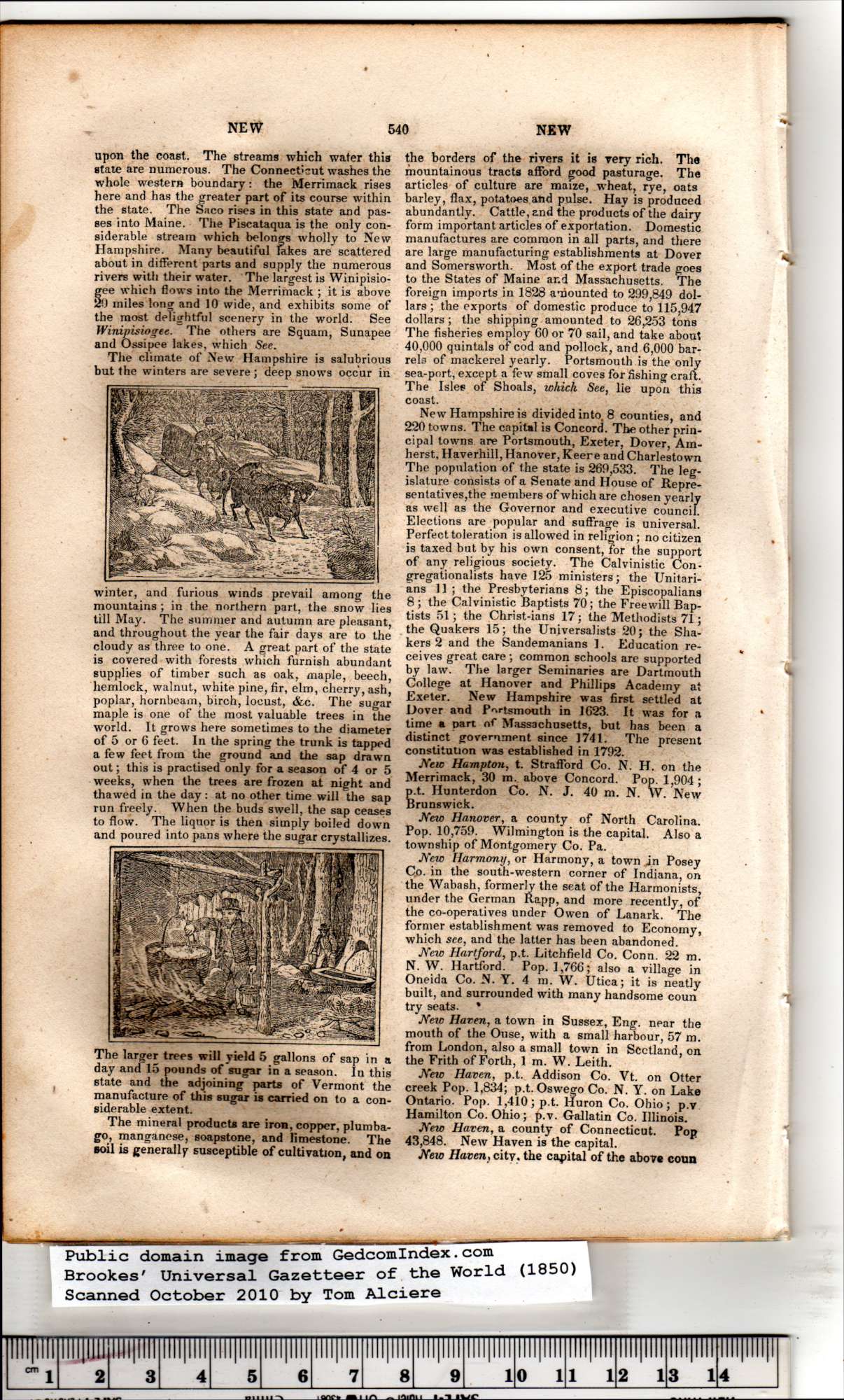|
upon the coast. The streams which water this
state are numerous. The Connecticut washes the
whole western boundary: the Merrimack rises
here and has the greater part of its course within
the state. The Saco rises in this state and pas-
ses into Maine. The Piscataqua is the only con-
siderable stream which belon*s wholly to New
Hampshire. Many beautiful Sikes are scattered
about in different parts and supply the numerous
rivers with their water. The largest is Winipisio-
fee which flows into the Merrimack ; it is above
0 miles long and 10 wide, and exhibits some of
the most delightful scenery in the world. See
Winipisiogec. The others are Squam, Sunapee
and Ossipee lakes, which See.
The climate of New Hampshire is salubrious
but the winters are severe; deep snows occur in
winter, and furious winds prevail among the
mountains ; in the northern part, the snow lies
till May. The summer and autumn are pleasant,
and throughout the year the fair days are to the
cloudy as three to one. A great part of the state
is covered with forests which furnish abundant
supplies of timber such as oak, maple, beech,
hemlock, walnut, white pine, fir, elm, cherry, ash,
poplar, hornbeam, birch, locust, &c. The sugar
maple is one of the most valuable trees in the
world. It grows here sometimes to the diameter
of 5 or 6 feet. In the spring the trunk is tapped
a few feet from the ground and the sap drawn
out; this is practised only for a season of 4 or 5
weeks, when the trees are frozen at night and
thawed in the day: at no other time will the sap
run freely. When the buds swell, the sap ceases
to flow. The liquor is then simply boiled down
and poured into pans where the sugar crystallizes.
The larger trees will yield 5 gallons of sap in a
day and 15 pounds of sugar in a season. In this
state and the adjoining parts of Vermont the
manufacture of this sugar is carried on to a con-
siderable extent. |
The mineral products are iron, copper, plumba-
go, manganese, soapstone, and limestone. The
soil is generally susceptible of cultivation, and on
the borders of the rivers it is very rich. The
mountainous tracts afford good pasturage. The
articles of culture are maize, wheat, rye, oats
barley, flax, potatoes and pulse. Hay is produced
abundantly. Cattle, and the products of the dairy
form important articles of exportation. Domestic
manufactures are common in all parts, and there
are large manufacturing establishments at Dover
and Somersworth. Most of the export trade goes
to the States of Maine and Massachusetts. The
foreign imports in 1828 amounted to 299,849 dol-
lars ; the exports of domestic produce to 115,947
dollars; the shipping amounted to 26,253 tons
The fisheries employ 60 or 70 sail, and take about
40,000 quintals of cod and pollock, and 6,000 bar-
rels of mackerel yearly. Portsmouth is the only
sea-port, except a few small coves for fishing craflt.
Tbe Isles of Shoals, which See, lie upon this
coast.
New Hampshire is divided into, 8 counties, and
220 towns. The capital is Concord. The other prin-
cipal towns are Portsmouth, Exeter, Dover, Am-
herst, Haverhill, Hanover, Keere and Charlestown
The population of the state is 269,533. The leg-
islature consists of a Senate and House of Repre-
sentatives,the members of which are chosen yearly
as well as the Governor and executive council.
Elections are popular and suffrage is universal.
Perfect toleration is allowed in religion; no citizen
is taxed but by his own consent, for the support
of any religious society. The Calvinistic Con-
gregationalists have 125 ministers; the Unitari-
ans 11 ; the Presbyterians 8; the Episcopalians
8 ; the Calvinistic Baptists 70; the Freewill Bap-
tists 51; the Christ-ians 17; the Methodists 71;
the Quakers 15; the Universalists 20; the Sha-
kers 2 and the Sandemanians I. Education re-
ceives great care; common schools are supported
by law. The larger Seminaries are Dartmouth
College at Hanover and Phillips Academy at
Exeter. New Hampshire was first settled at
Dover and Portsmouth in 1623. It was for a
time a part of Massachusetts, but has been a
distinct government since 1741. The present
constitution was established in 1792.
New Hampton, t. Strafford Co. N. H. on the
Merrimack, 30 m. above Concord. Pop. 1,904;
p.t. Hunterdon Co. N. J. 40 m. N. W. New
Brunswick.
New Hanover, a county of North Carolina.
Pop. 10,759. Wilmington is the capital. Also a
township of Montgomery Co. Pa.
New Harmony, or Harmony, a town jn Posey
Co. in the south-western corner of Indiana, on
the Wabash, formerly the seat of the Harmonists,
under the German Rapp, and more recently, of
the co-operatives under Owen of Lanark. The
former establishment was removed to Economy,
which see, and the latter has been abandoned.
New Hartford, ph. Litchfield Co. Conn. 22 m.
N. W. Hartford. Pop. 1,766; also a village in
Oneida Co. N. Y. 4 m. W. Utica; it is neatly
built, and surrounded with many handsome coun
try seats. *
New Haven, a town in Sussex, Eng. near the
mouth of the Ouse, with a small harbour, 57 m.
from London, also a small town in Scotland, on
the Frith of Forth, 1 m. W. Leith.
New Haven, ph. Addison Co. Vt. on Otter
creek Pop. 1,834; ph. Oswego Co. N. Y. on Lake
Ontario. Pop. 1,410; ph. Huron Co. Ohio; p.v
Hamilton Co. Ohio; p.v. Gallatin Co. Illinois.
New Haven, a county of Connecticut. Pop
43,848. New Haven is the capital.
New Haven, city, the capital of the above coun |
